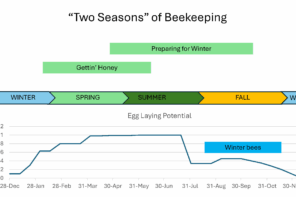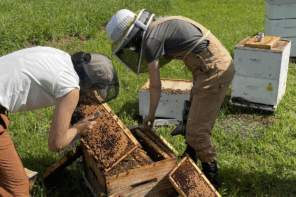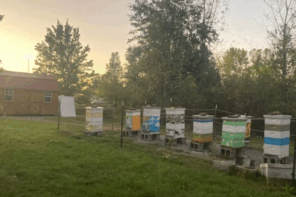A Nice Way to Put It
Ed Colby
I only have to utter the magic words “climate change” in one of my columns, and somebody fires off a letter accusing me of promoting some “leftwing agenda.” Yet like any elephant in the room, the dramatic environmental changes brought on by global warming merit our attention, and a little blow-back comes with the territory. I can’t please everybody. Why would I want to?
In John Miller’s delightfully disparaging piece on the Siren song of treatment-free beekeeping in the October issue of this magazine, his prose got downright colorful. Good, because sometimes you have to let it all hang out. Maybe I did a fist pump. John carried the torch for a cause I believe in. Control your mites. Save your bees.
Predictably, not everyone was pleased. Two letter writers took issue in the November Bee Culture. Both said or at least implied that they were successful treatment-free beekeepers. This would make them rare birds indeed. Neither said that they kept their bees in isolated locations.
It’s no secret that if you live out in the boonies beyond the flight range of other managed colonies you can make a go of treatment-free beekeeping. If you’re willing to take some big losses along the way, live-and-let-die natural selection may eventually leave standing some colonies that can make it on their own with no outside help. You’ve created a closed mini-ecosystem, populated exclusively by mite-resistant bees. Good for you!
But most of us live in communities, not out back of beyond. If your neighbors’ treatment-free bees get overwhelmed by mites and collapse from Varroa-vectored viruses, your bees can and will pick up hitchhiking mites when they rob honey from these hives. Now your no-treatment colonies have a potentially very big problem. They need to deal not only with their permanent-resident mites but also with an influx of newcomers. This horizontal transmission of mites, from hive to hive, is one reason no-treatment beekeeping is so challenging.
It’s mid- November as I write. Some of my treated colonies have succumbed to Varroa, with a few 300-bee sugar-shake samples coming in at 50-plus mites. These high-mite colonies lose most of their bees very quickly. This, after two Apiguard (thymol) treatments, or an Apivar (amitraz) treatment. Here in Colorado at 5,500 feet, we experience dramatic day/night temperature swings, and I suspect I may have administered the Apiguard too late, when cool nights reduced its effectiveness. In beekeeping, timing is everything. The lesson here is that when you administer a treatment, you need to do it when the treatment is most effective, and not wait until you get around to it.
In some of my colonies, Apivar showed reduced efficacy, with stable or even higher mite numbers four to six weeks post-treatment. But in other hives in the same yard I got a good knockdown.
So what did I do, too late for some, just in time for other colonies? I gave ‘em the hotfoot. I dribbled a weak solution of oxalic acid between the frames. This treatment is hell on mites, as long as there’s little or no sealed brood in which they can safely hide and reproduce.
Herein lies the rub. When I dribbled ten days ago, some colonies had gone broodless. Others, not so much. I had planned to dribble later, in late November or early December, when the queens should be reliably shut down and the brood mostly hatched.
My grand plan was to keep my mite numbers acceptably low through November (ideally under 10 for a 300-bee-sugar-shake sample) by treating with Apivar or Apiguard and then finishing off the survivors with that oxalic dribble.
So much for the grand plan. The mites had their own strategy, which was to strike early and overwhelm as many of my colonies as they could.
Prior to dribbling, I didn’t have time to mite-sample all my hives, or to look for brood in all of them. Today, November 18, ten days post-dribble, the results are not what I’d hoped for. My sampling of 10 hives found that all but one tested positive for mites. Thirteen in a 300-bee sample was the high count, and the rest were under 10. I saw more brood and more mites than I wanted to.
I opted to dribble early because I felt I had to. My mite numbers were unacceptably high, and I didn’t know what else to throw at ‘em. Now, after dribbling, my mite counts are not as low as I’d like going into Winter. But re-treatment later when they’re reliably broodless is a no-go, because more than one application of oxalic can kill long-lived Winter bees that are key to colony survival.
All right then. I made my bed. Now I’ll lie in it. Failure is, of course, the greatest teacher. Next year I’ll stay on top of my mite testing and treatments. I promise!
My friend Megan lives just down the road from one of my yards, and she likes to come along. She’s the opposite of a treatment-free beekeeper. A couple of years ago she learned the hard way. Now she’s an obsessive Varroa killer. I tease her because she freaks out if she sees even one mite in a sugar shake sample. But now the joke’s on me, and Megan gets the last laugh. The other day when we looked at one of my colonies that got decimated by mites she said, “Those used to be your best bees!”
On the way home we opened her two hives. Both were three-high, eight-framers boiling over with Apis mellifera. “Wow! Your little darlings put my bees to shame,” I said.
“I have you to thank for that. You taught me. And Ed, when the student shows up the teacher, that’s the crowning achievement of a really good teacher, isn’t it?”
What a nice way to put it.









